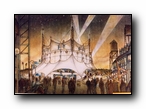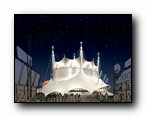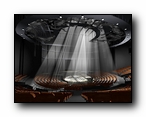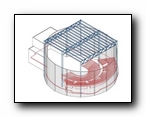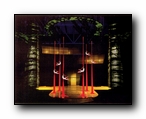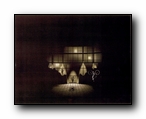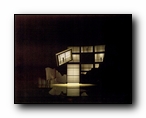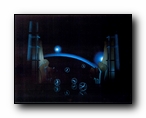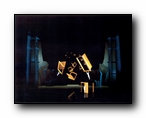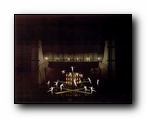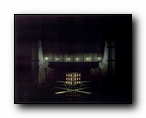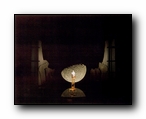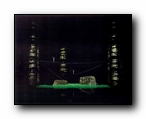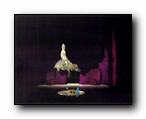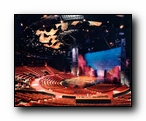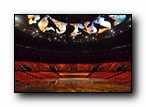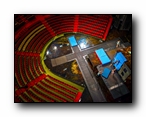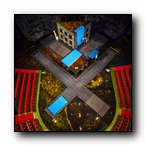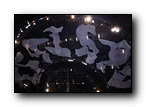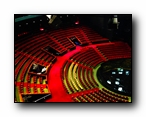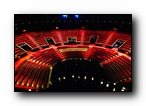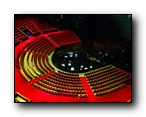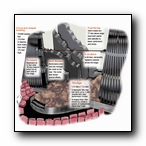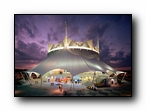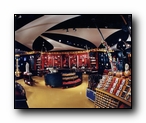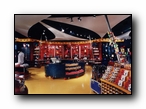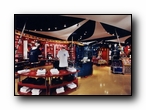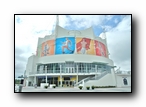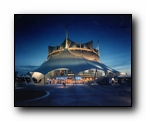
![]()

[ You are here: Grand Chapiteau | Creations | La Nouba | Scénographie ]
Création
Expérience
RéserveRetiré
Odyssey
On the inside of this concrete-canvas behemoth, on the second floor, rests its performance space. Like many of Cirque's theaters, the first thing you'll notice upon entering is the set and out-in-the-round stage. The set, which has been referred to as an “Elizabethan-style” stage due to its symmetrical style, is said to be reminiscent of a well-traveled path or trail. While that may be true, many see the insane nature of an asylum, and certainly that too is true. That asylum-esque nature is created with a 60×200 foot trellis construct made of PVC panels and scrim, which allow for wonderful projection and shadow play conjuring up uncanny images of Orwellian reminiscence. The wonderful backdrop is overshadowed by mountainous outcroppings, jetting up from the floor on either side. These rocks stand approximately 60-feet tall and are constructed of hard steel, but padded using wood and bleached velour (a velvet-type material.) Even the showroom seats are abound with detail; modeled after old-fashioned auditorium chairs, these seats are steel and wood constructed and covered in red velvet. They were built by American Seating of Grand Rapids, Michigan especially for La Nouba. But look up from your red-colored seats and see the seven cloud-like “Fabulous Figures” that decorate the ceiling of the showroom; their whimsical dance about the tops of the theater forever captured. These “figures” are manufactured out of copper tubing and wrapped in mesh and measure approximately 30-feet in length. You may not know, though, that these fanciful leapers were designed by Michel Crête, the set designer. You may spot the musicians next, resting upon two platforms housed in the 75-foot towers rising on either side of the stage. Separated but not disconnected from the performance, these musicians play the various notes of La Nouba's live music. They do so by staying connected via a complex audio system that allows each musician to speak with the bandleader, their other band mates and take direction if something were to happen. Usually the tick of a metronome is heard throughout their setup to keep everyone on the same beat and time. The platforms themselves are nothing more than steel planks welded together (among other various pieces) and contain an external elevator (which performers rise and lower from during the show. The stage has many technological achievements also. The retractable Power Track, as it is called, is 60 feet in length and fully automated, which means computers control the retraction (at 2-feet- per-second) of this enormously powerful trampoline. But don't let that quick retraction fool you into thinking the floor is light; it's not, it weighs over 10,000 pounds! The Power Track was specially designed by Cirque du Soleil (and Paco Corp.) to allow the performers to jump higher and faster than ever. The PowerTrack is the next evolution of the FastTrack as seen in Alegría. Ironically the PowerTrack became so popular that it was installed in Alegría, taking the old FastTrack's place. The stage comes alive during the performance by a set of elevators commonly referred to as lifts. There are five in all, resting just below the stage surface. The ascent and descent of these lifts are controlled by numerous motors (45 in all!) that must be in complete working order for the lifts to even function. The five lifts themselves rise to a maximum height of 16-feet; the center stage lift is also capable of descending 16-feet below the stage for a 32-feet range of motion! And they each have a 3,000 pound weight capacity. The stage itself is protected by an impact-resilient material called “Mondo Sport Floor” applied over wood in order to avoid injuries to the acrobats and dancers. Two télépheriques (or tracks) installed along the back wall of the stage are 78-feet (24-meters) above the ground and are capable of moving props, scenery and acrobatic equipment during the show at 4-feet-per-second. These tracks provide an easy system for moving objects in and out of view of the spectators. You'll find various strange props, lights and chairs gliding by throughout the various acts including “The Grand Monument,” a 40×30 foot structure of aluminum and painted scrim. The set is fully automated as well. The theater's immense height enabled scenic and acrobatic equipment to be stored in the ceiling. The 25×60-foot Trapeze Net (designed by Doug Kiddell of Cirque du Soleil), for example, is protracted and retracted by eight motors, including two 40-horsepower tensioning winches with up to 5,000 pounds of force. Not one soul comes out to set up or tear down the trapeze net. Additional set pieces are operated using a motorized counterweight system, such as: the trampolines (which descend from the ceiling), the flying doors (of which there are 9), the petite fenêtre volante (or New York Window,) two pedestal platforms and the four trapeze grips. The JR Clancy Company of Syracuse, New York installed the 44-line set rigging system and 35 of the winches used for these props. The lifts were designed and installed by Showmotion of Connecticut in partnership with Disney Ride and Show Engineering. Westsun Scenic Edge, Inc. of Winnipeg actually designed and installed the computer control system, which makes the space come alive using a Windows NT based program called Dynatrac. But "sometimes low tech is the best stuff," head rigger Dave Phillips said, pointing out a chandelier hanging down from below the grid as an example. He said that a rigger takes the chandelier off its hook and drops it down into the theater. It is backed up by a bungie so it has a slow, smooth motion when it goes down. "We just couldn't get the right look for it" by using technology, Phillips said. "Sometimes the best solutions are the easiest and cheapest." Another fairly low-tech solution Phillips explained was the method he and his crew used to design one of the show's sets, a group of flapping doors that behave a bit like birds. He said that Cirque management demanded the look, but it was no easy task coming up with a way to do it. Finally, though, he and his team settled on a motor system that wags the doors with what he called "rotisserie action" on the end. With fixed tiered seating in a 180-degree semicircle around the stage, the auditorium has neither a proscenium arch nor an architectural ceiling, which makes it similar to many of Cirque's other theatrical ventures. To some, the first glimpse provides the image of a traditional big top; to others, it is Cirque du Soleil's greatest achievement. Regardless of how you see it, it is a one-of-a-kind structure for Cirque du Soleil in that it's Cirque's first stand-alone theater complex, but also a self-contained Cirque world. What do I mean? For the first time, a show space, ticket booths and Boutique (which Scéno Plus also designed) are housed directly in the same complex. Michel Crête, Set Designer, sums it all up thusly: "La Nouba is a show that occupies two spaces at once: the world of the modern urban centre, and the world of childhood dreams and visions. In La Nouba, these worlds are not mutually exclusive: they blend endlessly, one into the other. Railroad tracks lead to fairy tales, factories become castle ramparts, and magic continually explodes into the mundane. The set of La Nouba is like a factory, or a childhood attic filled with dreams and nightmares. You never know for sure whether you're in the world of fantasy or reality. Ordinary objects very quickly become fantastical, like the upside-down bicycle. That's why doors, windows, are so important: you're always in-between. It's deliberately open, deliberately layered. How you see it depends very much on you as a spectator."
Bright orange, lime green, saturated red, chrome yellow. These are just a few of Lighting Designer Luc Lafortune's weird color choices that look absolutely delicious as they prowl playfully around the stage in La Nouba.Not too many lighting designers would make the choices (or take the risks) that Lafortune does. But the creative canvas at Cirque du Soleil is broad enough to let his imagination run wild with light. A man on a tightrope walks through a Parisian park with dappled cobblestones projected onto the stage floor. Stark towers of white light cut through billowing smoke. An LED message from cyberspace--".com delete exit @ www shift"--flickers in the darkness.With the use of gobos (projected patterns) and additional lighting integrated into the set, the result is a dynamic and versatile stage atmosphere. To achieve more interesting projections, stock gobos were trimmed with high-temperature aluminum tape and shutter cuts were used to produce grid shaped patterns of light. "The use of patterns creates different environments," says Lafortune, whose lighting rig for La Noubaconsists of 1,250 theatrical lighting instruments, including such items as Altman punch lights, High End Systems Dataflash units and Diversitronics strobes, as well as Wildfire UV fixtures, over 1,000 ellipsoidals and PARs from Altman, City Theatrical, and ETC, a battery (38) of moving lights from High End Systems and Clay Paky, six Robert Juliatfollowspots, and dozens (150) of Wybron color scrollers that are capable of delivering over a half-million watts of light on stage. The lighting control system includes over 1,000 dimmers utilizing a Strand Light Palette 550-I to control the conventional fixtures and strobe lights and a Flying Pig Systems Whole Hog II for moving lights control in the show. Special effects for La Nouba are controlled by a Strand Light Palette 520-I lighting console. Ten stage smoke machines and four hazers are incorporated into the set and mounted in the grid above the stage. A 3,000-gallon tank of liquid nitrogen supplies the burst effects. Starting with the idea that there might be something lurking under your bed in the dark, or someone moving around in the attic, La Nouba evolved into an urban myth with circus figures lost in a zany metropolis. "The scenery is not too specific," says Lafortune, who points out that designer Michel Crete gave him a set of black shapes to light. "They are reminiscent of castles and dungeons, with mountains or ruins in the background." The upstage wall, a wooden grid with 3"-square openings, stands in front of a khaki scrim. "The lightness of this color responded very well to the colors of the light," says Lafortune, who adorned it with projections of clouds and star fields. He also hung some High End Studio Colors horizontally on the back wall and directed the light out toward the audience.The other moving lights are used more traditionally. "They are used more in a rock and roll sense," Lafortune admits. "There is more movement, more flashing, and more strobing than in any Cirque production in a long time. This was dictated by the notion of urbanity and the rhythm of the music." Despite its unusual color palette, La Nouba is a pretty dark show and earned Lafortune a new nickname: the Prince of Darkness. "There is a constant contrast between an urban look and a feeling of romanticism," says Lafortune, who has carved an exquisite universe out of the dark.
The front-of-house sound booth is equipped with a Cadac F-type console with 72 dual inputs, feeding 10 Level Control System LD-88's creating an integral 80x80 matrix. This provides the ability to automate mixes and dynamic changes, as well as the placement and movement of the sound image throughout the showroom. Additionally, the LCS (Level Control System) provides all equalization and delays, playback, control of all effects and other external devices via MIDI. Seven computers are used in the sound booth to provide Cadac cue control, acoustical analysis and backup. For processing, the system uses three Symetrix voice processors, eight Aphex expander/gates with Aural Exiters, equalizers and compressors. Lexicon gear includes two PCM-81's, two PCM-91's and two 300's controlled by a LARC. An additional console is used to provide monitor mixes for each of the eight musicians. The mix stems provided by the outputs of the Crest console are fed to each musician's own Yamaha Pro-Mix enabling them to control their own mixes and recall cues and presets as needed. The main speaker system is comprised of Meyer cabinets capable of producing 45,000 watts of amplification. Sound co-Designers Jonathan Deans and François Bergeron configured the system with its upper and lower, left and right main clusters including 26 MSL2's, 10 Renkus-Heinz SR61's and 14 EAW AS300E's to provide a wide stereo image and coverage throughout the room. Another system, installed to produce pre- programmed sound effects in the mid-aisle of the theater, consists of 12 Tannoy CMS6TDC8 speakers that can be activated by infrared beams. |


